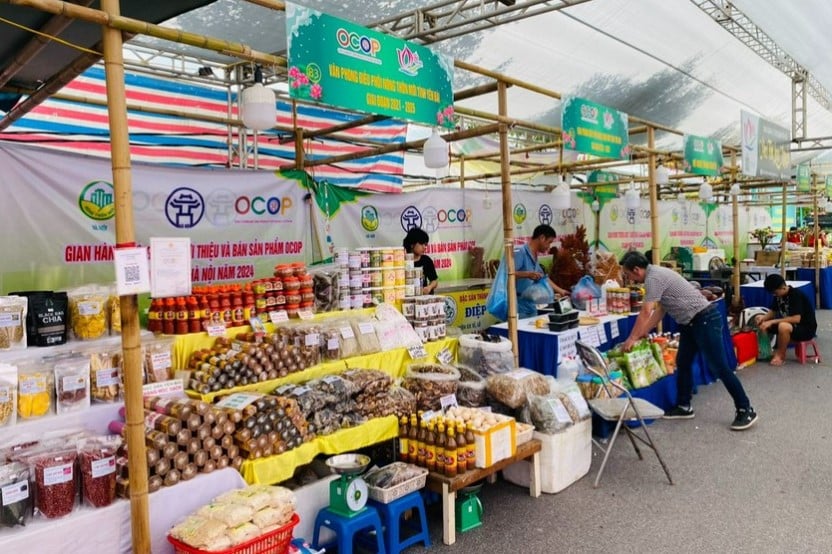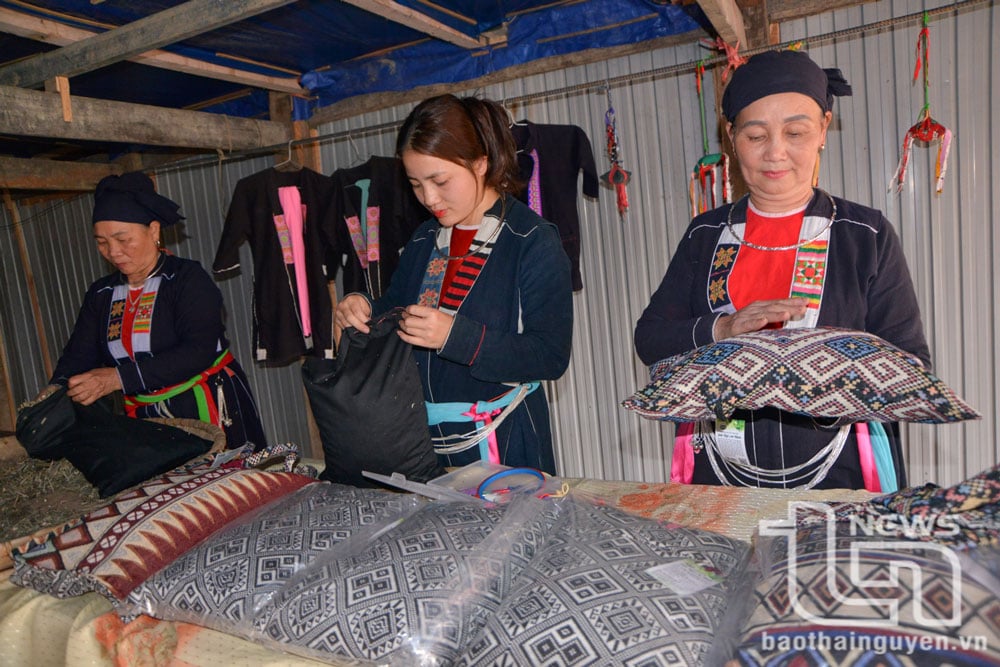With only bamboo traps, fishermen sail a few nautical miles out to sea early in the morning to set traps for squid, and harvest them at the end of the day. This simple fishing method is providing a stable source of income for many fishermen in coastal areas.

The result after a trapping trip is fresh squid - Photo: LA
At My Thuy beach, Hai An commune, Hai Lang district, around 2-3 pm every day, people can easily see dozens of 10-24 CV motorboats of fishermen starting their engines and heading straight to the sea to collect squid from traps that have been set on the seabed since early morning.
Sharing after returning to shore with nearly 10 kg of fresh squid, fisherman Phan Thanh Hiep happily said that the squid trapping profession has been around for more than 20 years.
Fishing season is usually from February to July every year. The trap location is 1-4 nautical miles from shore, with water depth from 5-10 m, maximum about 20 m.
Each squid trapping boat usually has 2 people, the number of traps is usually from 20 - 60. Like his boat with a capacity of 24 CV, each trip he can carry 50 traps.
To catch squid, Mr. Hiep usually sets sail early in the morning. After about 30 minutes of travel, the boat arrives at the predetermined location, about 2 - 3 nautical miles from shore.
With more than 15 years of experience at sea, he only needs to look at the water, currents and weather to know where the squid gather. When he arrives, he and his crew prepare traps, and others attach clusters of fresh squid eggs to the traps as bait.
Then, as the boat moved, he dropped each trap into the sea. Where there was a lot of squid, the traps were dropped more densely.
To secure the cage, the bottom of the trap is tied to a stone or sandbag weighing about 5 - 7 kg to keep the cage submerged in the sea. The top of the cage is connected to a rope 20 - 30 m long, tied to a buoy floating on the water surface. The time to lower the cage into the sea is about 30 - 40 minutes.
“The profession of setting up squid cages is currently being exploited quite effectively by fishermen in coastal communes, especially in communes in Hai Lang district. It is easy to do and provides a stable income, so except for rainy days, fishermen all go to set up squid cages. Depending on the number of cages and the location, the amount of squid collected each day is different. But on average, with about 50 cages, each boat can collect 3-7 kg of squid. Some boats that set up their cages and catch squid can collect 15-20 kg. With the current price of about 350,000 VND/kg, it is calculated that each day fishermen earn 1.5-2.5 million VND, after deducting expenses, they earn 700-1.2 million VND per person. In addition, there are also some large-capacity fishing boats doing this job, such as fishing boat QT 93679TS captained by Mr. Nguyen Khanh Quoc, which regularly exploits the fishing grounds of Bach Long Vy island with an income of hundreds of millions of VND each. trip Mr. Le Duc Thang, Deputy Head of Fisheries Exploitation Management and Logistics Services Department, Department of Fisheries. |
To avoid confusion with other people's traps, each person marks his own buoy with a separate symbol. Then he turns the boat to shore to rest and wait until about 2-3 pm, then returns to collect the traps. When he reaches the location of each buoy, he uses a pole about 2 m long with a hook attached to the end to pull the rope that ties the buoy up.
According to Mr. Hiep, not all traps catch squid. Sometimes, after pulling 4 or 5 traps in a row, he still doesn't catch any squid. But sometimes, not only squid are caught inside, but some traps also trap cuttlefish weighing nearly a kilo.
“This job is very unpredictable, some days I earn a few million VND but other days I lose money on fuel. But the balance is still stable. This trip was considered a success. With the purchase price at the shore from traders from 350,000 VND/kg, after deducting expenses, each of us shared about 1.7 million VND,” said Mr. Hiep.
Not far away, Mr. Phan Thanh To was meticulously repairing a squid trap in time for tomorrow's squid trapping trip. Now 70 years old, Mr. To has more than 20 years of experience in squid trapping.
The trap is made of a rectangular bamboo frame 1.2 m long, 0.6 m wide and high, covered with a layer of nylon mesh with a mesh size of about 2 cm. The mouth of the trap is two pieces of mesh closed enough for the squid to enter but not exit.
The surrounding area is covered with dried leaves of the Indian laurel tree or black nylon tarpaulin to create a dark area inside the cage. To carry more cages on the boat, instead of tying them together, the corners of the cages are connected with soft plastic to help fold the cages during the move to the fishing grounds. Thanks to that, small boats can also carry 15-20 cages, large boats can carry up to 40-60 cages.

Mr. Phan Thanh To, My Thuy village, Hai An commune, Hai Lang district, repairs a damaged squid trap to prepare for a new sea trip - Photo: LA
According to Mr. To, the structure of a squid trap is simple, but when released into the sea, each step must be followed precisely: from setting up the cage, tying ropes, tying rocks, and attaching bait.
The special thing about squid trapping is that unlike trapping other animals using food or placing traps on the road, fishermen have to lure them to lay eggs in the trap. Therefore, the bait for squid in the trap is the most attractive cluster of fresh squid eggs.
Mr. To explained that squids usually lay eggs in coral reefs, so when they see the cage on the seabed, they think it is a coral reef and go in to lay eggs. Therefore, the squid eggs in the trap must be fresh, the female squid will smell the smell and come in to lay eggs, and the male squid will follow.
To keep squid eggs fresh for use over many days, immediately after pulling up the cage, fishermen must remove the squid eggs and put them in a bucket of clean seawater.
“This is the time when squid come close to shore to spawn, so when they see eggs in the trap, they go in to lay eggs and cannot escape. We just pull them up and catch them,” said Mr. To.
According to Mr. To, compared to other marine occupations, squid trapping is quite easy because it does not cost much but the income is relatively high.
On average, the cost to make a trap is only about 20-30 thousand VND; the cost of fuel to run the machine to move to the fishing grounds is only about 70-100 thousand VND. The work of those who make squid traps is only during the day, not overnight like many other seafaring jobs.
Every day, fishermen go to sea twice a day, at 5am to release the traps and at 2pm to collect the traps. If there is squid, they bring it back to sell to traders. The remaining traps are folded and stacked on the boat. If there are dirty or damaged traps, they are cleaned and repaired, and then taken back to sea the next day to continue trapping squid.
“With this job, on a good day I can catch 2-3 kg of squid, on a good day I can catch 7-8 kg, sometimes I can catch over 20 kg. In general, it is enough to take care of my family,” said Mr. To.
Le An
Source


![[Photo] Prime Minister Pham Minh Chinh meets with King Philippe of Belgium](https://vstatic.vietnam.vn/vietnam/resource/IMAGE/2025/4/1/be2f9ad3b17843b9b8f8dee6f2d227e7)


![[Photo] President Luong Cuong and King Philippe of Belgium visit Thang Long Imperial Citadel](https://vstatic.vietnam.vn/vietnam/resource/IMAGE/2025/4/1/cb080a6652f84a1291edc3d2ee50f631)
![[Photo] General Secretary To Lam receives King Philippe of Belgium](https://vstatic.vietnam.vn/vietnam/resource/IMAGE/2025/4/1/e5963137a0c9428dabb93bdb34b86d7c)
![[Photo] Close-up of Vietnam's sniffer dog team searching for earthquake victims in Myanmar](https://vstatic.vietnam.vn/vietnam/resource/IMAGE/2025/4/1/d4949a0510ba40af93a15359b5450df2)











![[6pm News] Of the 40 newly discovered gold mines, 4 are in Thanh Hoa](https://vstatic.vietnam.vn/vietnam/resource/IMAGE/2025/4/1/08644991aa1b4030a549159f2f87c0d6)












![[Photo] Myanmar's capital in disarray after the great earthquake](https://vstatic.vietnam.vn/vietnam/resource/IMAGE/2025/4/1/7719e43b61ba40f3ac17f5c3c1f03720)



























































Comment (0)